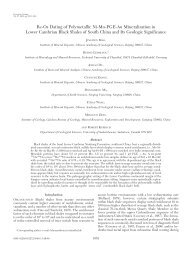Uranium Ore Deposits
Uranium Ore Deposits
Uranium Ore Deposits
Create successful ePaper yourself
Turn your PDF publications into a flip-book with our unique Google optimized e-Paper software.
EDUCATION<br />
Fig. 10:<br />
Schematic representation of<br />
a roll-front deposit where a<br />
crescent-shaped uranium ore<br />
body forms at the dynamic<br />
reaction front in the sandstone<br />
aquifer between oxidized and<br />
reduced lithologies. The redox<br />
front moves with meteoric water<br />
flow more and more inside the<br />
original reduced rock unit, driven<br />
by hydraulic head.<br />
Fig. 11:<br />
Schematic W-E crosss section<br />
over 500 km from the Karatau<br />
Moutains to Lake Balkash<br />
(Central Kazakhstan). Sandstonehosted<br />
uranium deposits formed<br />
where regional-scale oxidized<br />
groundwater flow in Cretaceous-<br />
Tertiary aquifers encountered<br />
methane and hydrogen sulfide<br />
released from underlying gas<br />
fields. These deposits host<br />
around 1.1 Gt U at a low grade of<br />
~0,03-0.05 % U easily extracted by<br />
ISL („In-Situ Leach“) mining.<br />
Modified from Jaireth et al. (2008).<br />
The IOCG („Iron oxide-Copper-Gold“) deposit style is<br />
mainly known from the Gawler craton in southern Australia,<br />
with the supergiant Olympic Dam deposit standing<br />
out. The latest total resource figures make this deposit<br />
the largest uranium deposit known, although uranium is<br />
only a by-product of copper mining: 8.3 Gt @ 0.88 % Cu,<br />
0.24 kg/t U, 0.31 g/t Au, 1.50 g/t Ag (BHP Billiton Annual<br />
Report 2008). Mining is currently still underground, but a<br />
multi-billion open-pit project with exceptional dimensions<br />
is under way. The Olympic Dam Cu-U-Au deposit consists<br />
of a huge Mesoproterozoic (~ 1590 Ma) granite breccia<br />
complex with abundant hematite (up to 90 %) and minor<br />
magnetite, as well as sulfides, and its formation is not well<br />
understood. This deposit has produced 3,500 t U in the<br />
past year (1 July 2007 to 30 June 2008, as to BHP Billiton<br />
reporting style), and is the only important uranium deposit<br />
of the IOCG style.<br />
There is a variety of other uranium ore deposits of<br />
currently less economic importance. These cover all geological<br />
environments. The hydrothermal environment has<br />
classical vein type and shear-zone related deposits which<br />
were important in the early days of uranium mining. A<br />
large part of the European uranium production came from<br />
such veins systems in the Hercynian fold- and thrust-belts<br />
of the Bohemian Massif/Erzgebirge (Czech Republic and<br />
Germany) and the French Massif Central. An important<br />
part of the East German uranium production came from<br />
Early Paleozoic black shales in the Ronneburg district<br />
which picked up much uranium at a synsedimentary redox<br />
front (euxinic environment) which then probably became<br />
upgraded on weathering. This deposit style is known from<br />
other regions, particularly from the Cambrian alum shale in<br />
Sweden, where the uranium grade around 0.1 % U is below<br />
current economic feasibility (Fig. 6).<br />
Issue 02 | 2008<br />
www.advanced-mining.com<br />
23










